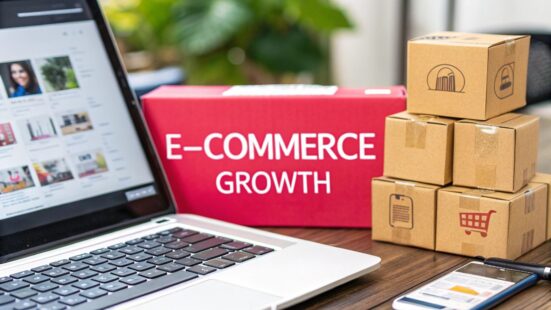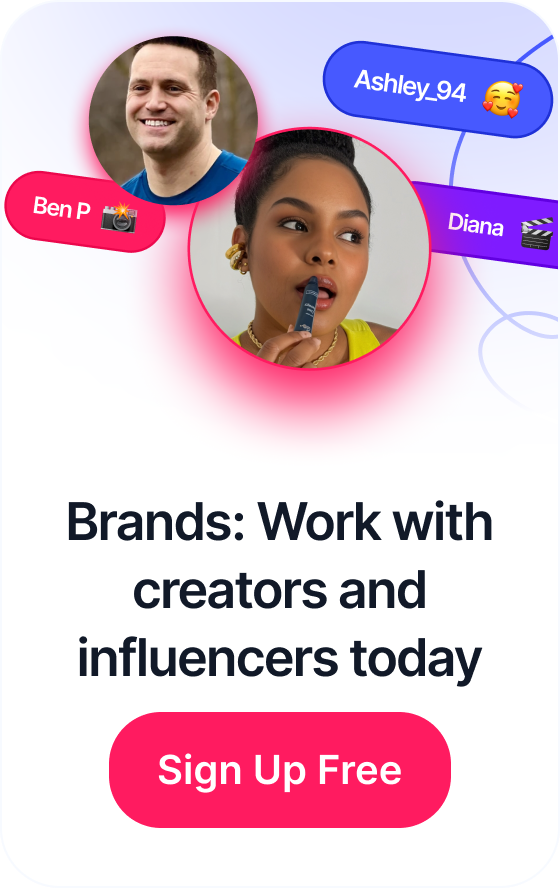 How to Collaborate with Influencers A Practical Guide
How to Collaborate with Influencers A Practical Guide
At its core, an e-commerce growth strategy is simply your game plan for getting new customers, boosting sales, and keeping the customers you already have. It’s the roadmap that connects all your marketing, sales, and even your day-to-day operational decisions, making sure every move you make pushes you toward real, sustainable expansion. Flying without one? You're just guessing.
Table of Contents
Building Your Foundation for Scalable Growth

You wouldn't build a skyscraper without a rock-solid foundation, right? The same logic applies to your e-commerce brand. Jumping into aggressive growth tactics before you’ve audited what you're currently doing is like building on sand—it's just a matter of time before it all comes crashing down.
This first phase isn't about pie-in-the-sky ideas. It's about taking a brutally honest look at what’s working and, more importantly, what’s quietly bleeding you sales.
Start with your digital storefront. Is your website’s user experience (UX) actually smooth, or are people ditching their carts because of confusing navigation or a clunky checkout? Even tiny friction points add up to massive revenue loss over time. Then, look behind the curtain at your logistics. Can your fulfillment process actually handle a sudden 2x or 3x in orders? These details are the true bedrock of a business that's ready to scale.
Setting Clear Goals and Measurable KPIs
Saying you want to "increase sales" isn't a strategy; it's a wish. To make real progress, you need goals that are specific, measurable, achievable, relevant, and time-bound (SMART). A well-defined objective gives your entire team a clear target to hit.
For example, swap that generic goal for something concrete: "Increase customer lifetime value (CLV) by 15% within the next six months." Now that is a target. It's specific, you can measure it, and it immediately directs your focus toward activities that improve customer retention.
A goal without a metric is just a wish. Your key performance indicators (KPIs) are the vital signs of your business, telling you if your strategy is working or needs adjustment.
Here are a few of the non-negotiable KPIs you should be tracking for e-commerce growth:
- Customer Acquisition Cost (CAC): Exactly how much does it cost you to land one new customer?
- Conversion Rate: What percentage of people who visit your site actually make a purchase?
- Average Order Value (AOV): What's the average amount customers spend each time they check out?
- Customer Lifetime Value (CLV): How much revenue does a single customer bring in over their entire relationship with your brand?
Truly Understanding Your Ideal Customer
You probably know your customers' basic demographics—age, location, the usual stuff. But do you get their psychographics? A winning growth strategy is built on a deep, almost empathetic understanding of the people you're selling to. You need to dig past the surface-level data to find their real motivations, their hidden fears, and what actually triggers them to buy.
What problem does your product really solve for them? Is it about saving time? Boosting their confidence? Helping them nail a personal goal? When you're laying the groundwork, consider how proven top affiliate marketing strategies for growth can act as a powerful engine to reach these customers where they are.
When you understand your customer's core needs, you can craft marketing messages that hit them on an emotional level. That's how you turn casual browsers into die-hard brand fans. This deep customer insight is, without a doubt, the most valuable asset in your entire strategic arsenal.
Mastering Traffic and Customer Acquisition

Alright, your foundation is solid. Now comes the real fun: getting a steady stream of qualified traffic to your store. This isn't about just getting clicks; it’s about connecting with shoppers who are actively hunting for what you sell. The best e-commerce growth strategies weave multiple channels into a single, cohesive system that brings the right people to your digital doorstep.
Forget about chasing every shiny new platform. Your energy is much better spent mastering a few key areas that drive consistent, high-intent traffic. This mindset shift takes you from just "doing marketing" to building a predictable engine for customer acquisition.
Building a Strong SEO Presence
Search Engine Optimization (SEO) is the art and science of showing up when people are actually searching for your products. It’s definitely not a quick fix, but it's hands-down the most valuable long-term investment you can make in your brand's visibility. Good SEO makes your business discoverable 24/7, without you having to pay for every single click.
A solid e-commerce SEO strategy really boils down to a few critical bases:
- Technical Site Health: First thing's first—make sure your site is fast, mobile-friendly, and easy for search engines to crawl. Slow load times or broken links are silent killers for your rankings.
- On-Page Optimization: This is all about using the right keywords in your product titles, descriptions, and category pages. Put yourself in your customer's shoes: what words would they type into Google to find what you're selling?
- Problem-Solving Content: Don't just sell; solve problems. Create blog posts, guides, and videos that answer your customers' biggest questions. A store selling high-end blenders could create content comparing smoothie recipes or explaining the benefits of different blade types. This captures search traffic from people who aren't quite ready to buy but are deep in the research phase.
Smart Paid Advertising for Immediate Impact
While SEO is your long game, paid advertising delivers immediate traffic and—just as importantly—valuable data. Platforms like Google Ads and Meta (Facebook and Instagram) let you target customers with incredible precision based on their demographics, interests, and online behavior. The key here is to focus on return on ad spend (ROAS), not just vanity metrics like impressions.
For instance, a brand that sells custom pet portraits could use Meta ads to target users who follow popular pet influencers or have shown interest in pet adoption pages. This ensures their budget is spent reaching an audience that's highly likely to be interested in their unique product. Getting these campaigns right from the start is crucial, so it pays to understand the fundamentals of what performance marketing is and how it ties directly to your bottom line.
Your paid ad budget isn't an expense; it's an investment in data. Every campaign, whether it succeeds or fails, teaches you more about your audience, your messaging, and what drives conversions.
The global e-commerce market is set for massive growth, projected to hit around $8.3 trillion by 2025—a 55.3% jump from 2021. This explosive expansion shows just how critical a sharp, mobile-focused acquisition strategy is, especially since over 70% of all e-commerce purchases are expected to happen on mobile devices. You can discover more insights about the future of online payments and the e-commerce market on clearlypayments.com to get ahead of the curve.
Tapping Into Authentic Voices with UGC and Influencers
Let's be real: modern shoppers trust people more than they trust ads. This is where user-generated content (UGC) and influencer partnerships become your secret weapons for building trust and reaching new audiences. Authentic content from real customers and creators just feels more genuine and cuts through the noise of traditional advertising.
Think about a skincare brand. A glossy, professional ad is one thing. But a real video from a creator showing their morning routine and how they actually use the product? That’s far more relatable and convincing. This kind of content provides powerful social proof that your products actually work.
This is where platforms like JoinBrands come in. We connect e-commerce businesses directly with a huge network of creators who can produce this kind of authentic content at scale. You can find influencers for a big campaign or source a steady stream of UGC from creators to use in your social media ads, on your product pages, and in your email marketing. This approach not only builds credibility but also gives you a constant supply of high-quality creative, helping you test what resonates most with your audience without blowing your budget on expensive studio shoots.
Turning Visitors Into Paying Customers
Getting traffic to your store is just the first lap of the race. The real win comes when those visitors actually pull out their credit cards and buy something. This is where your e-commerce growth strategy truly shows its value—turning curious clicks into completed sales. It’s all about conversion rate optimization (CRO), the art and science of making it as easy and compelling as possible for a user to make a purchase.
Every single element on your product pages and throughout your checkout process either helps or hurts this goal. There's no middle ground. From the words you choose to the color of a button, each detail adds up to your final conversion rate.
Crafting Product Pages That Convert
Think of your product page as your best digital salesperson. It has to be persuasive, informative, and completely trustworthy. The average e-commerce conversion rate floats around 2-3%, which means for every 100 people who visit, only two or three become customers. Improving your product pages is the single fastest way to beat that average.
Start with your visuals. Are your product photos high-resolution? Do you show them from multiple angles and, most importantly, in use? If you sell jackets, show one on a model, not just lying flat on a white background. If it's a tech gadget, include a quick video demo. These visuals bridge the mental gap between seeing an item online and imagining it in your hands.
Next, sharpen your copy. Your descriptions should do more than just list features; they have to sell the benefits. Instead of just saying "10,000 mAh battery," try something like, "Power your phone for an entire weekend on a single charge." This kind of language speaks directly to a customer's problems and makes your value crystal clear. The right product descriptions are a huge part of an effective e-commerce content strategy that builds desire and seals the deal.
Your product page has one job: to answer every question and overcome every objection a potential customer might have before they even think to ask.
Finally, social proof is absolutely non-negotiable. Displaying customer reviews, star ratings, and user-generated content (UGC) builds immediate trust. One study found that products featuring reviews see a 12.5% higher conversion rate. Seeing photos of real people happily using your product is infinitely more powerful than any marketing copy you could ever write.
Streamlining the Path to Purchase
Did you know that nearly 70% of online shopping carts are abandoned? The number one reason is a clunky or confusing checkout process. Every extra field, every unnecessary step, is another chance for a customer to get frustrated and walk away. A smooth checkout is the bedrock of any solid e-commerce growth strategy.
Here are some quick wins for reducing friction:
- Offer Guest Checkout: Forcing people to create an account is a notorious conversion killer. Always, always provide a guest option.
- Simplify Your Forms: Only ask for what is absolutely essential. Do you really need their phone number right now?
- Show Their Progress: Use a simple progress bar to show shoppers exactly where they are in the process (e.g., Shipping > Payment > Confirm).
- Provide Multiple Payment Options: Offer popular choices like PayPal, Apple Pay, and Google Pay alongside the standard credit card fields.
The image below shows how this all works together in a cycle: you find the friction points, test potential fixes, and watch your conversion rate climb.

By mapping out the customer journey, you can pinpoint exactly where people are dropping off. From there, you can use A/B testing to validate improvements that directly boost your sales.
Implementing High-Impact CRO Tests
If you want to systematically improve your conversion rates, you have to stop guessing and start testing. A/B testing, where you show two different versions of a page to different groups of visitors, is the gold standard for data-driven optimization. Don't assume what works—let your customers' actions tell you.
To get you started, I've put together a table of practical, high-impact tests you can run on your site. Think of this as your priority list for turning more of those hard-earned visitors into loyal customers.
High-Impact Conversion Rate Optimization Tests
| Test Area | Hypothesis Example | Potential Impact | Implementation Effort |
|---|---|---|---|
| Product Page CTA | A green 'Add to Cart' button will outperform our current blue one. | High | Low |
| Checkout Process | Removing the 'Phone Number' field will reduce cart abandonment. | Medium | Low |
| Homepage Headline | A benefit-focused headline will lower the bounce rate vs. a feature-focused one. | Medium | Low |
| Shipping Information | Displaying "Free Shipping Over $50" in the header will increase AOV. | High | Medium |
| Product Imagery | Adding a product video will increase the 'Add to Cart' rate. | High | High |
Start with the low-effort, high-impact tests to get some quick wins under your belt. As you gather data and build momentum, you can move on to the more involved optimizations. Every successful test is another step toward building a more profitable e-commerce machine.
Creating a Powerful Customer Retention Engine
Getting new customers through the door is exciting, but the real secret to sustainable e-commerce growth? It’s all about keeping the ones you’ve already won over.
Let's be real: it costs way more to attract a new buyer than to get a current one to come back. Plus, loyal customers are the ones who consistently spend more over time. This is where you build real, profitable growth—by turning one-time buyers into genuine brand fans.
That’s where a customer retention engine comes in. It's not just a buzzword; it's a deliberate system you build to nurture relationships, inspire loyalty, and maximize the lifetime value (CLV) of every single customer.
Nurturing Relationships with Email and SMS Marketing
Email and SMS aren't just for blasting promotions; they're your direct lines of communication to your customer base. When used correctly, they become powerful tools for building actual relationships. The trick is to ditch the generic campaigns and fully embrace smart segmentation and automation.
Stop sending the same newsletter to everyone on your list. Instead, get strategic and segment your audience based on their actual behavior:
- New Customers: Kick things off with a welcome series. Tell your brand story, show off your best-sellers, and make them feel like they've joined something special.
- Repeat Buyers: These are your VIPs. Reward their loyalty with early access to new drops or exclusive discounts that nobody else gets.
- Inactive Subscribers: Haven't seen them in a while? Send a friendly "we miss you" offer or highlight what’s new and exciting since their last visit to get them back.
Automation is what makes this personalized approach possible. When you set up triggered campaigns—like abandoned cart reminders or post-purchase follow-ups—you're talking to customers at the most critical moments of their journey. For a deeper dive, our guide on e-commerce marketing automation lays out a full blueprint for setting up these killer workflows.
A great retention strategy makes your customers feel seen and valued, not just marketed to. Personalization is the bridge between a transaction and a relationship.
Designing a Loyalty Program That Actually Works
One of the biggest mistakes I see brands make is launching a loyalty program that's too complicated or offers rewards no one actually wants. An effective program needs to be simple, easy to use, and provide real value that encourages people to shop again.
Consider a tiered system. As customers spend more, they unlock better perks. For instance, a basic tier might offer points per dollar spent, but a premium tier could include free shipping on all orders, early access to sales, and even a special birthday gift. This approach gamifies the experience and gives customers a clear reason to stick with your brand.
Perfecting the Post-Purchase Experience
The moment a customer clicks "buy" isn't the end of their journey. It's the beginning of the most critical phase for building loyalty. Everything that happens after the sale is where you prove you value their business beyond the transaction. This is where real trust is built.
Focus on proactive and transparent communication. Don't make customers hunt down their tracking information. Send them timely shipping updates via email or SMS. A simple "Great news! Your order has shipped" message can make all the difference.
On top of that, a hassle-free returns process is non-negotiable. Nothing sours a customer's perception of your brand faster than a difficult or costly return. Make it easy, and you build confidence, showing them they can shop with you risk-free.
This focus on a seamless experience is more important than ever. By 2025, online sales are projected to account for about 24% of all global retail sales, hitting an incredible $7.4 trillion annually. You can discover more insights about e-commerce stats on explodingtopics.com to see how these trends are raising the bar for customer experience across the board.
Scaling Operations and Expanding Your Reach

Finally, your marketing is hitting its stride and the sales are rolling in. This is the moment every e-commerce entrepreneur dreams of. But this success brings a whole new set of high-stakes challenges. When your sales engine is firing on all cylinders, your backend operations are put to the ultimate test.
A real e-commerce growth strategy isn’t just about getting more traffic and sales; it’s about building a machine that can handle that success without collapsing.
As order volume picks up, every tiny inefficiency in your fulfillment or supply chain gets magnified. A minor shipping delay that used to affect a handful of customers a month now impacts dozens a day. This is where your ability to scale operations becomes the make-or-break factor for your long-term growth.
Leveraging Data for Strategic Expansion
Before you start dreaming of new international markets, take a hard look at the data you already have. Your customer analytics are a goldmine, often pointing to underserved segments or unexpected ways people are using your products.
Are you noticing a surprising number of orders from a specific city or region you don't even target? That’s not a fluke; it's a signal.
Use this intel to pinpoint promising new areas for expansion. Dig into the demographics and buying habits of these organic customer clusters. This data-first approach lets you expand intelligently, putting your money where there's already proven demand instead of just guessing where your next customers might be.
This is huge in a global context. The number of digital buyers worldwide is expected to hit 2.77 billion by 2025, which is about 33% of the entire global population. Emerging markets are a massive part of this growth, so you need targeted strategies that respect local habits and infrastructure.
Building a Resilient Supply Chain
A fragile supply chain is the Achilles' heel of any growing brand. As you scale, you need a system that's both efficient and resilient. For most, this means diversifying your suppliers and having solid backup plans for your logistics.
One of the biggest decisions you'll face is when to partner with a third-party logistics (3PL) provider. I get it—managing your own fulfillment feels cost-effective at first, but it quickly becomes a massive bottleneck.
A good 3PL partner doesn't just ship boxes. They provide the infrastructure and expertise to manage inventory, pick and pack orders, and handle returns at a scale that would be incredibly expensive to build yourself.
It’s probably time to consider a 3PL when:
- You spend more time taping up boxes than you do on marketing or product development.
- Your storage space (be it your garage or a small warehouse) is overflowing.
- You want to offer competitive shipping options like two-day delivery but can't manage it yourself.
Making this move at the right time is a game-changer, freeing you up to focus on what you actually do best—growing the business.
Using Smart Technology as a Competitive Edge
Scaling isn't just about hiring more people; it’s about working smarter. Modern tech, especially AI, gives you powerful tools to manage complexity and get a serious leg up on the competition. AI can fundamentally change how you run your operations, making your processes more predictive and efficient.
For example, AI-powered tools can analyze past sales data and market trends to give you incredibly accurate inventory forecasting. This helps you avoid costly stockouts on your bestsellers or getting stuck with too much inventory on slow-movers, which is great for your cash flow.
On the customer service side, AI chatbots can handle common questions 24/7. This frees up your support team to focus on the more complex issues that really need a human touch.
To pull your whole strategy together and scale without everything breaking, check out the best AI tools for digital marketing to automate tasks and streamline your workflow. By integrating these kinds of technologies, you build a smarter, more responsive business that can grow its footprint without sacrificing the customer experience that got you here.
Answering Your Toughest E-commerce Growth Questions
Even the most buttoned-up growth strategy runs into real-world roadblocks. It's one thing to have a plan on paper, but navigating the day-to-day decisions—where to spend your money, what numbers actually matter, and when to pivot—is a completely different ballgame.
Let's cut through the theory and get straight to the practical answers for the questions that keep founders and marketers up at night. Think of this as your field guide for the inevitable hurdles on the path to scaling your brand.
How Should I Prioritize Growth Initiatives with a Limited Budget?
When you can't do everything at once, ruthless prioritization becomes your superpower. The goal is simple: find the activities that promise the biggest bang for the least buck.
Before you spend a dime, you have to find the biggest bottleneck in your business. Is it a lack of traffic? A dismal conversion rate on your product pages? Or maybe you’re a leaky bucket, losing customers as fast as you get them? Your data will tell you exactly where the fire is. Pouring money into ads is useless if your checkout process is a clunky, broken mess.
A simple but powerful way to visualize this is the Impact vs. Effort matrix. Just map out all your potential growth ideas based on how much impact they'll have and how much effort (time and money) they’ll take.
- Quick Wins (High Impact, Low Effort): Jump on these immediately. We're talking about A/B testing your "Add to Cart" button color, rewriting product descriptions with better SEO keywords, or finally setting up that abandoned cart email sequence.
- Major Projects (High Impact, High Effort): These are the game-changers, like a full website redesign or expanding into a new international market. You absolutely need to plan for these, but don't let them paralyze you from getting the quick wins done now.
- Fill-Ins (Low Impact, Low Effort): Squeeze these in when you have a spare hour. This could be minor social media updates or tiny design tweaks that have been bugging you.
- Time Sinks (Low Impact, High Effort): Avoid these like the plague. A perfect example is building a complex, custom feature that only two of your customers have ever asked for.
This framework forces you to be brutally honest about where your resources should go, ensuring every dollar and every hour is actually moving the needle.
When the budget is tight, shift your focus to retention. It is almost always cheaper and easier to convince a past customer to buy again than it is to acquire a brand new one. A simple loyalty program or a targeted email campaign can deliver a mind-blowing ROI.
What Are the Most Important Metrics to Track?
You can't fix what you don't measure. But it’s just as dangerous to get lost in a sea of data, chasing metrics that don't mean anything for your bottom line.
Forget vanity metrics like social media likes or impressions. They feel good, but they don't pay the bills. To truly know if your growth strategy is working, you need to laser-focus on a handful of Key Performance Indicators (KPIs) that are directly tied to revenue and profit.
Your core e-commerce dashboard should be built around these four vital signs:
- Customer Acquisition Cost (CAC): How much do you have to spend in marketing and sales to land one new customer? If your CAC is creeping up, it’s a warning sign that your acquisition channels are getting less efficient or more expensive.
- Customer Lifetime Value (CLV): What’s the total profit you can expect to make from a single customer over their entire relationship with your brand? For a healthy business, your CLV needs to be much higher than your CAC. A 3:1 ratio is a solid benchmark to aim for.
- Conversion Rate: Of all the people who visit your website, what percentage actually make a purchase? This is the ultimate report card on how well your site, product pages, and offers are doing their job.
- Average Order Value (AOV): On average, how much do customers spend each time they check out? Simple tactics like product bundling ("buy the kit and save!") or smart upsells can increase your AOV, boosting revenue without needing a single new visitor.
By keeping a close eye on these four numbers, you get a crystal-clear, high-level view of your business’s health. It’s the difference between guessing and making genuinely data-driven decisions.
How Often Should I Revisit and Adjust My Strategy?
Your growth strategy isn't a stone tablet. It's a living document that needs to adapt, or it will become irrelevant. The e-commerce world simply moves too fast for a "set it and forget it" approach.
The best way to think about it is a constant cycle: plan, execute, measure, and then iterate.
Here’s a practical rhythm for keeping your strategy sharp:
- Weekly Check-ins: This is your tactical huddle. Spend 30 minutes looking at your core KPIs (CAC, CLV, Conversion Rate, AOV) and the performance of your active campaigns. Are your ads hitting their ROAS targets? Did conversions suddenly tank yesterday? These quick check-ins let you spot and fix small problems before they snowball.
- Quarterly Reviews: Time to zoom out. Every 90 days, take a harder look at the big picture. Are you on track to hit your annual goals? This is your chance to re-evaluate your priorities based on what you've learned. Maybe it's time to double down on that surprisingly profitable TikTok campaign or pull the plug on a channel that’s just not delivering.
- Annual Planning: Once a year, you need to go deep. This means a full competitive analysis, a fresh look at your ideal customer profile, and setting the major, ambitious goals for the next 12 months.
This cadence keeps you agile. It gives you the structure to stay focused on your long-term vision while providing the flexibility to react to new challenges and grab unexpected opportunities.
Ready to accelerate your growth with authentic content that converts? JoinBrands connects you with over 250,000 creators to produce high-impact UGC and run influencer campaigns at scale. Find your perfect creators on JoinBrands.








